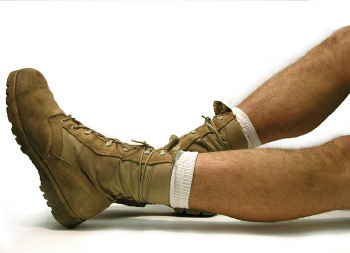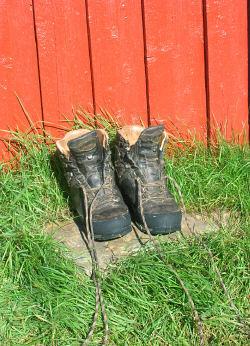Choosing the Right Hiking Boots
by Luther Mardock
 Hiking boots may be the single most important piece of your backpacking equipment. A bad pair of boots will ruin an otherwise meticulously planned trip. Blisters (caused by chafing), pinched toes, sore heels or other injuries are just a few of the consequences if you choose your boots unwisely. On the other hand, a well-fitted pair of quality hiking boots can make your time on the trail positively blissful. This doesn’t mean you need to spend a lot of money, however. The cost of a pair of boots varies widely. You could spend anywhere from around $80USD to as much as $300USD on a pair of boots, or even more for custom made boots. There is no need, however, to spend anywhere near $300USD for a pair of boots, especially if you’re planning to use them for hiking or moderate backpacking.
Hiking boots may be the single most important piece of your backpacking equipment. A bad pair of boots will ruin an otherwise meticulously planned trip. Blisters (caused by chafing), pinched toes, sore heels or other injuries are just a few of the consequences if you choose your boots unwisely. On the other hand, a well-fitted pair of quality hiking boots can make your time on the trail positively blissful. This doesn’t mean you need to spend a lot of money, however. The cost of a pair of boots varies widely. You could spend anywhere from around $80USD to as much as $300USD on a pair of boots, or even more for custom made boots. There is no need, however, to spend anywhere near $300USD for a pair of boots, especially if you’re planning to use them for hiking or moderate backpacking.
Here are a couple of things to consider when you’re starting your search for the right boots.
- Are you a casual weekend hiker? If so you may only need a pair of low hiking shoes. There are some excellent and versatile shoes that will give the added traction you’ll need on the trail, without the weight of a boot. If you have weak ankles, however, or will be traversing particularly rugged terrain, shoes may not be appropriate.
- If you plan on carrying anything more than a daypack with lunch, you will need a good pair of boots. The weight in your backpack on even an overnight trip could easily exceed forty pounds, and the support of a solid pair of boots is vital to prevent injury to your ankles. Generally speaking, leather boots provide more support than synthetic or fabric boots, though this is not always the case.
Going to the store or shopping online for boots can be a bewildering experience. There are dozens of sites, thousands of stores, and hundreds of choices. Fit is important and the only way to find the right boot is to have it on your foot, so the best way to find out what you need is to go to an outdoor or backpacking shop in person. Then, if you buy the boot online, it will be much easier once you have tried on a number of different boots. At some stores they may actually have a trained boot fitter that will be able to help you. Most likely, however, the salesperson will have no specific knowledge. Don’t let yourself be talked into buying boots that don’t feel right! Take your time! A good pair of boots can last for years.
Some tips to making sure your boot-fitting experience is a good one:
- Wear hiking socks to the store. If you don’t own any the store may have some that you can use to try on boots. Don’t leave the store without some new socks, however. There’s no reason to buy expensive boots if you’re going to wear them with cotton socks that will give you blisters anyway. High quality socks are usually wool blend with some nylon or lycra. Cheaper socks are acrylic, polyester, or even cotton. Good socks are worth the investment and will last a long time.
- Boots are fitted larger than most shoes. You will probably need to go at least a half size or more up from your normal shoe size. Heavyweight boots are sometimes fitted even larger. You should be able to move your toes, but you don’t want too much room or your foot will slide around inside the boot.
- If you can, try the boot out on an incline, make sure your foot does not slide forward when you’re walking downhill. Walk in the boots. You will not be able to leave the store, but spend as much time as possible in the boots before deciding, preferably an hour. Make sure that your foot is not rubbing and your heel is not lifting too much off the insole.
- Your boots may not seem as comfortable at first. Heavyweight boots, especially, are very stiff at first as they will likely have a full length metal shank in the midsole.
- Remember, your feet change, even throughout a normal day and especially after a long day on the trail. Your feet are largest later in the day.

At first glance, most boots will probably look just about the same. All boots are comprised of three basic parts: the upper, the midsole and the outsole. Each part, however, will vary widely in its construction, material, and suitability for your particular needs.
- The upper of most good quality boots is leather or a mix of leather and synthetic materials. You may also find different grades of leather. Full grain leather is the thickest and most durable grade, which will provide the most support and protection, but is also quite stiff and may be difficult to break in. Split grain leather has had the inner portion of the hide removed, leaving only a thinner layer for waterproofing. This type of leather will be easy to break in, but lacks the durability and support of full grain. High quality boots will also include some time of synthetic waterproofing material, such as Gore-Tex in addition to the leather outer layer.
- The midsole of a hiking boot is similar to that of most athletic shoes. The type of midsole will be determined by the intended use of the boot. A cushioned midsole is more likely to be found in hiking shoes and lightweight boots and will be similar to that in running shoes. Mid-weight and heavy weight boots do not generally have significant padding in the midsoles.
- The sole of the boot is what will keep you on your feet. There is wide variety of different patterns used, and most boot manufacturers have several different proprietary patterns. All are designed to work on any surface; however, some will work better on some surfaces than others. In general, look for a multidirectional tread pattern that will provide good traction on a wide variety of surfaces and under any conditions.

It is important to remember that just because a boot is recommended to you by a friend or even an experienced expert, it does not mean that it is the right boot for you. Manufacturers use proprietary lasts (the forms shoe makers use) that are designed to accommodate certain types of feet. Some may have narrower ‘European’ lasts that are narrower at the toe. Now, that doesn’t mean that it might not be right for you, but don’t be discouraged if the boot your friends swear by doesn’t feel right on your foot. Only you can find the right boot for yourself. Do some research and then go to the store and try on every boot they have.
Once you’ve found your boot remember to give it sufficient wear to break it in before you hit the trail. Take some long walks, with a loaded bag if possible; this will get both you and your boots in shape for the trail. And remember that once you’ve made the investment in a good pair of boots, some basic maintenance will extend their useful lives. Buy some type of external water proofing agent and some leather treatment such as mink oil.
Happy hiking!
>> Hunt for great deals on hiking boots in the BootsnAll travel gear store!
Luther Mardock is an educator and free-lance writer in Lincoln, Nebraska who enjoys providing informative tips to consumers when shopping for boots. He has backpacked throughout the US, Europe and Africa.